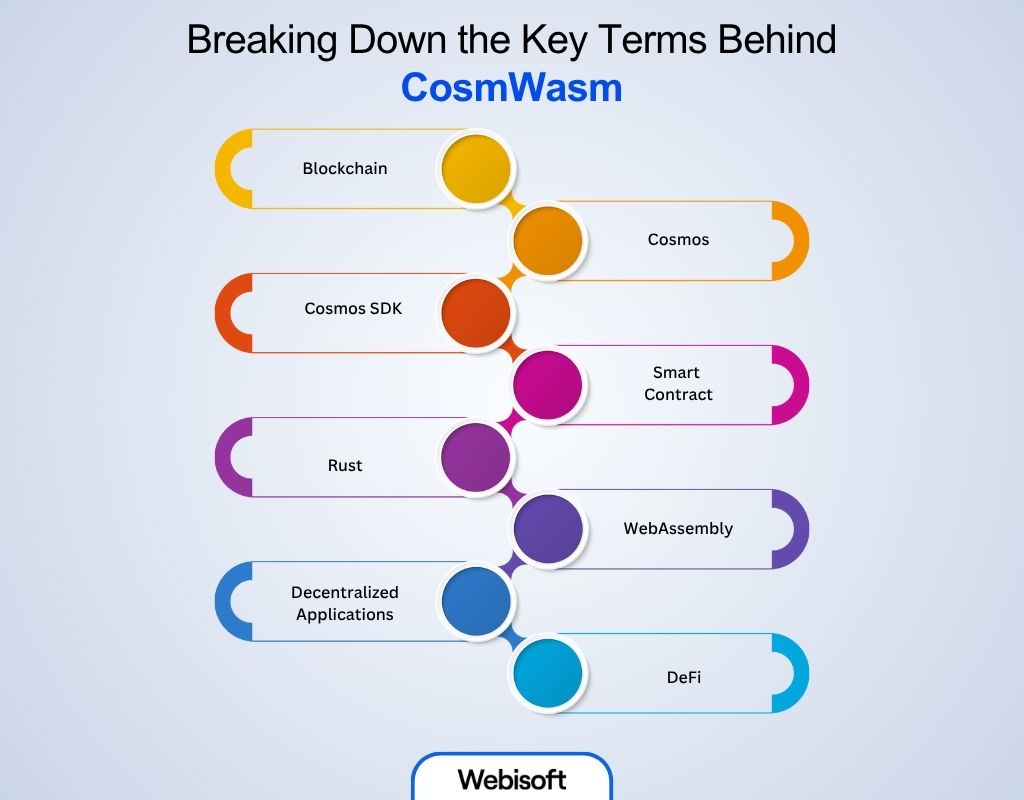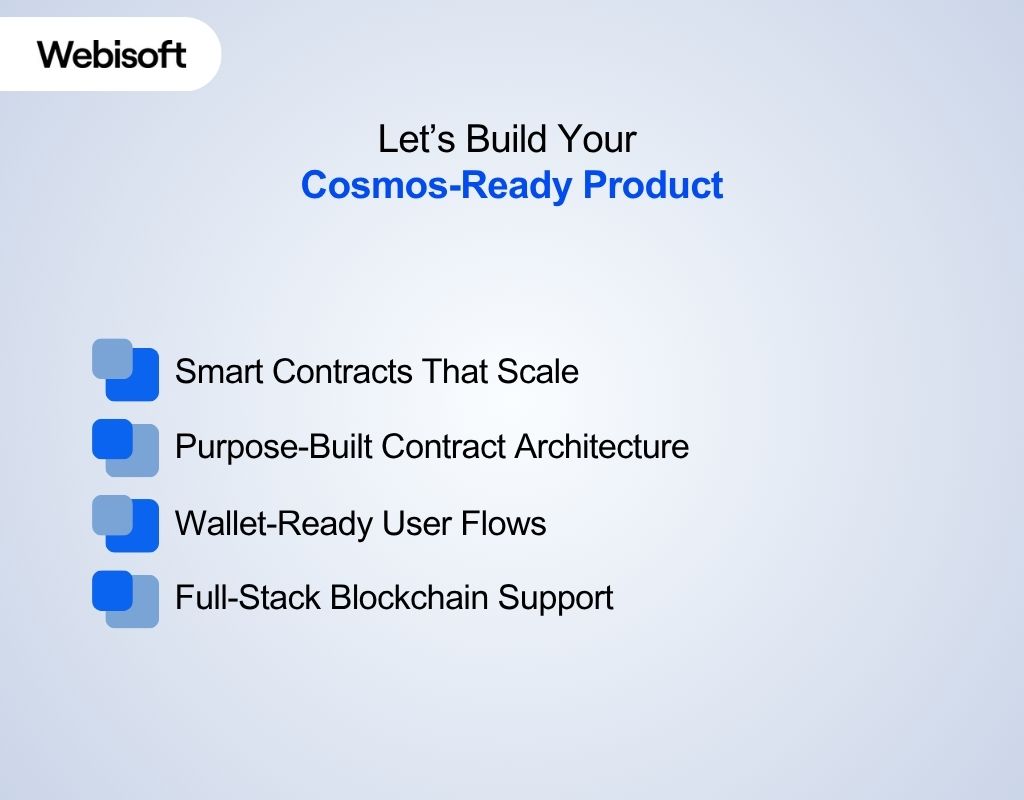What Is CosmWasm? The Smart Contract Engine Explained
- BLOG
- Blockchain
- October 11, 2025
CosmWasm is quickly gaining recognition as a leading smart contract engine within the Cosmos ecosystem. While its inner workings can be complex, this article will break down the key ideas in a way that’s easy to understandn even if you’re new to blockchain technology.
Unlike other engines that rely on Ethereum’s virtual machine, CosmWasm runs contracts compiled to WebAssembly (Wasm), offering greater security, flexibility, and performance. What makes CosmWasm special is this allows developers to build innovative applications like decentralized finance, NFTs, and DAOs that can work together within the Cosmos network.
Its popularity is clear: over 30 blockchains use CosmWasm, with thousands of applications and millions of transactions each month, according to official Cosmos data. This rapid growth shows how important CosmWasm has become for blockchain development in Cosmos and beyond.
Contents
- 1 What is CosmWasm?
- 2 Build your CosmWasm application with Webisoft now!
- 3 Breaking Down the Key Terms Behind CosmWasm
- 4 How Blockchains, Cosmos, and CosmWasm Work Together
- 5 Key Functions of CosmWasm
- 6 How CosmWasm Works: Step-by-Step Transaction Process
- 6.1 Step 1: Receiving the Transaction
- 6.2 Step 2: Loading the Contract Code
- 6.3 Step 3: Running the Contract in a Sandbox
- 6.4 Step 4: Accessing and Modifying Contract State
- 6.5 Step 5: Consuming Gas for Computation
- 6.6 Step 6: Ensuring Deterministic Output
- 6.7 Step 7: Interacting with Blockchain Features
- 6.8 Step 8: Completing the Transaction
- 7 Why Rust Is the Language Behind CosmWasm
- 8 Introduction to CosmWasm Development
- 9 Let’s Build Your Cosmos-Ready Product
- 10 Final Words
- 11 Frequently Asked Questions
What is CosmWasm?
CosmWasm is an open-source smart contract engine designed to be integrated into blockchains built using the Cosmos SDK.
It allows these blockchains to run smart contracts written in Rust, compiled to WebAssembly (Wasm), enabling them to support decentralized applications (dApps) such as DeFi, NFTs, DAOs, and more.
Having a hard time getting all that in…?
For now, here is a very simple way to understand what cosmwasm is.
CosmWasm is like a helper for blockchains. It lets people write clear instructions for what the blockchain should do, and then it makes sure those instructions are followed automatically. This means the blockchain can do things on its own, without anyone needing to watch over it or press buttons.
Build your CosmWasm application with Webisoft now!
Schedule a free consultation and launch secure, scalable smart contracts on the Cosmos network today!
Breaking Down the Key Terms Behind CosmWasm
To properly understand CosmWasm, you first need to know the basic terms that come together to make it work. Here is a clear explanation of each concept, what role it plays, and how it connects to CosmWasm.

Blockchain
A blockchain is a digital record-keeping system that stores information in a secure and unchangeable way. Think of it as an online ledger that everyone can see, but no one can tamper with. In the Cosmos ecosystem, many blockchains are built using the Cosmos SDK.
Relation to CosmWasm: CosmWasm runs on these blockchains to enable more advanced features.
Cosmos
Cosmos is a network of separate blockchains that can communicate and exchange information with each other. Instead of being one big chain, it is made up of many smaller blockchains working together.
Relation to CosmWasm: CosmWasm operates within this network on blockchains built using the Cosmos SDK.
Cosmos SDK
The Cosmos SDK is a set of tools developers use to create new blockchains within the Cosmos network. It makes the process of building a blockchain faster and more customizable.
Relation to CosmWasm: CosmWasm is an optional module that can be added to blockchains built with the Cosmos SDK to give them smart contract capabilities.
Smart Contract
A smart contract is an automated set of rules written by developers that runs on a blockchain. Once these rules are set, they execute on their own without the need for human control. For example, a smart contract can say, “If X happens, then do Y.”
Relation to CosmWasm: CosmWasm is the system that allows these smart contracts to run on Cosmos SDK blockchains.
Rust
Understanding Rust is a must if you want to know what is CosmWasm. Rust is the programming language used to write smart contracts for CosmWasm. It is known for being fast, safe, and reliable.
Relation to CosmWasm: Developers write the smart contracts in Rust, which CosmWasm then runs.
WebAssembly (Wasm)
WebAssembly, often called Wasm, is a format that turns smart contract code into something computers can process efficiently and securely.
Relation to CosmWasm: CosmWasm runs smart contracts that have been compiled into Wasm.
Decentralized Applications (dApps)
Decentralized applications, or dApps, are apps that run on a blockchain instead of being controlled by one company or person. They operate based on smart contracts.
Relation to CosmWasm: CosmWasm allows these applications to function on Cosmos blockchains.
DeFi
DeFi stands for decentralized finance. It refers to financial services like lending, trading, and borrowing that run on blockchains using smart contracts, without banks or middlemen.
Relation to CosmWasm: Many DeFi applications on Cosmos blockchains rely on CosmWasm smart contracts..
How Blockchains, Cosmos, and CosmWasm Work Together
To make all of this simple, imagine that a blockchain is like a shared notebook where people can write down important events or transactions. The Cosmos network is like a neighborhood where many of these notebooks exist, each one belonging to a different community but with the ability to communicate with each other when needed.
The Cosmos SDK is the toolkit that helps people build new notebooks (blockchains) in this neighborhood. However, if you want your notebook to do more than just record events, if you want it to automatically carry out tasks based on certain instructions, you need smart contracts. This is where CosmWasm comes in.
CosmWasm is like the engine that reads the instructions written by developers and makes sure the blockchain follows them automatically. Developers write these instructions in a language called Rust, which is then turned into a format called WebAssembly (Wasm) that the engine can read easily.
Thanks to CosmWasm, blockchains in the Cosmos network can host applications that no one controls directly, like financial services (DeFi), digital collectibles (NFTs), or community decision-making systems (DAOs). CosmWasm makes it possible for these blockchains to act on their own, following clear instructions without needing manual input or a central authority.
In short, Cosmos provides the playground, the Cosmos SDK builds the playground equipment, and CosmWasm brings the magic that lets the equipment work automatically, opening up endless possibilities for what blockchains can do.
CosmWasm in the Cosmos Ecosystem: Its Place in the Stack
In the Cosmos technology stack, CosmWasm occupies a clearly defined position. At the base is CometBFT, which handles the crucial tasks of networking and consensus ensuring that all participants in the blockchain network agree on what has happened. Sitting above CometBFT is the Cosmos SDK, the framework that provides the essential building blocks for creating custom blockchains. CosmWasm is layered on top of the Cosmos SDK, serving as the execution environment for smart contracts.
This structure introduces the Wasm Virtual Machine (VM) into the stack, where smart contracts, written in Rust, are securely executed. These contracts function like independent accounts within the blockchain, with their own addresses and the ability to send and receive transactions. This allows blockchains to automate tasks and manage decentralized applications directly on-chain.
This flowchart explains what is CosmWasm from a birds eye view:
The placement of CosmWasm in this layered architecture ensures smooth interaction with both standard Cosmos modules (such as banking or staking) and any custom modules specific to a given blockchain. It also enables seamless cross-chain communication using Inter-Blockchain Communication (IBC) protocols, allowing smart contracts to operate across multiple blockchains.
This modular arrangement with CometBFT at the base, Cosmos SDK as the middle layer, and CosmWasm handling smart contract execution provides the flexibility, security, and interoperability that define the Cosmos ecosystem.
Key Functions of CosmWasm
CosmWasm serves as the smart contract engine for Cosmos SDK blockchains, enabling a range of essential functions that make decentralized applications possible. Its primary functions include:
- Smart Contract Execution
CosmWasm runs the automated programs in smart contracts that follow predefined rules on the blockchain securely and efficiently. - State Management
It manages the storage and retrieval of data for each contract, keeping contract information isolated and secure within the blockchain state. - Security and Isolation
CosmWasm ensures that contracts run in a sandboxed environment, preventing unauthorized access to blockchain internals and protecting the system from harmful code. - Gas Metering and Resource Control
By tracking computational resource usage (gas), CosmWasm prevents contracts from consuming excessive resources, avoiding network slowdowns or crashes. - Inter-Contract Communication
Contracts can call or interact with other contracts securely, enabling complex decentralized applications built from multiple contract components. - Contract Lifecycle Management
CosmWasm handles deployment, initialization, execution, and upgrades of smart contracts, supporting their ongoing development and evolution. - Cross-Chain Compatibility
Because it runs on Cosmos SDK blockchains, CosmWasm contracts can be deployed across multiple chains within the Cosmos ecosystem, enabling interoperability.
How CosmWasm Works: Step-by-Step Transaction Process

Understanding what is CosmWasm includes understanding the step by step process of its inner mechanics. When a transaction calls a smart contract on a Cosmos SDK blockchain with CosmWasm enabled, the following process occurs:
Step 1: Receiving the Transaction
The blockchain node receives a transaction that invokes a specific CosmWasm smart contract.
Step 2: Loading the Contract Code
CosmWasm loads the compiled WebAssembly (Wasm) bytecode of the called contract into its embedded WebAssembly Virtual Machine (VM) within the node.
Step 3: Running the Contract in a Sandbox
The contract executes inside a secure, isolated sandbox environment provided by the VM. This ensures the contract cannot affect the blockchain’s core systems or access unauthorized resources.
Step 4: Accessing and Modifying Contract State
The contract reads any required data from its isolated storage, which is securely mapped to the blockchain’s key-value store. After processing, it writes any state changes back to this storage through CosmWasm’s controlled interface.
Step 5: Consuming Gas for Computation
As the contract executes, CosmWasm measures the computational effort (gas) used. If the contract’s gas consumption exceeds the allocated limit, execution stops and all changes are rolled back to protect the network.
Step 6: Ensuring Deterministic Output
CosmWasm guarantees that contract execution is deterministic, producing the same result on every blockchain node, which maintains consensus across the network.
Step 7: Interacting with Blockchain Features
If the contract needs to interact with the blockchain. For example, transferring tokens or querying balances, it does so through a restricted API exposed by CosmWasm, ensuring secure and authorized operations.
Step 8: Completing the Transaction
Once execution completes successfully within gas limits and without errors, CosmWasm finalizes state changes and returns the outcome of the transaction to the blockchain for consensus and inclusion in the ledger.
Why Rust Is the Language Behind CosmWasm
CosmWasm smart contracts are written primarily in Rust, a modern programming language known for its speed, safety, and reliability. Rust’s strong emphasis on memory safety helps prevent common programming errors that could lead to security vulnerabilities. This is an essential feature when handling valuable assets on a blockchain.
Moreover, Rust compiles efficiently to WebAssembly (Wasm), the format CosmWasm uses to run smart contracts. This compatibility ensures that contracts perform well while maintaining strict safety guarantees, making Rust an ideal choice for building secure and high-performance decentralized applications within the Cosmos ecosystem.
Introduction to CosmWasm Development

This section provides a high-level overview of the main concepts and documentation pages to help you get started with CosmWasm development. We are linking to the pages to official CosmWasm website for the details. We are not writing in detail here because this is a large and complicated topic.
Here at Webisoft, we develop CosmWasm smart contracts for a living. So, it is easier for us. But it might not be the same for you. And we have also included some community links that will hopefully make the process easier.
Getting Started
Start by setting up your development environment and quickly deploying contracts using wasmd. These initial steps are documented in:
Basics of Smart Contract Development
The core of CosmWasm smart contract development includes building, querying, testing, and managing state:
- Create a Rust Project
- Define Entry Points
- Build the Contract
- Create and Test Queries and Testing Queries
- Multitest Introduction
- Manage Contract State
Execution and Contract Design
Understand how to structure execution messages and deal with attributes, events, and funds:
Actor Model in CosmWasm
CosmWasm embraces the actor model for contracts, which simplifies asynchronous and stateful interactions:
Cross-Contract Communication
For advanced use cases, CosmWasm allows contracts to interact with each other:
Further Resources
To go deeper or explore real-world examples:
- Main CosmWasm Docs
- Cosmos SDK Documentation
- External Articles and Use Cases, Sumble Overview, Comdex Use Case
For community-contributed tutorials and articles, consider:
This overview gives you the foundational entry points into CosmWasm. You can branch into more advanced topics like IBC, DAO governance, and DeFi applications as you progress. Here is a source from CosmWasm to help you build it.
Let’s Build Your Cosmos-Ready Product

Smart Contracts That Scale
At Webisoft, we help teams go beyond basic deployments with smart contracts built for performance, security, and growth. If you’re developing on Cosmos, our CosmWasm integration services ensure your contracts run smoothly on any Cosmos SDK chain.
Purpose-Built Contract Architecture
We design, test, and maintain modular smart contracts tailored to real-world applications. Our CosmWasm contract development process supports everything from MVPs to high-volume DeFi platforms.
Wallet-Ready User Flows
For apps that rely on on-chain transactions or user identity, we connect smart contracts to smooth front-end experiences through expert wallet development.
Full-Stack Blockchain Support
Our broader technical expertise helps you align smart contract logic with backend systems, devops, and product strategy for a launch-ready experience.
Looking for a team that understands smart contract engineering from the ground up? Let’s build something reliable, scalable, and ready for the Cosmos ecosystem.
Final Words
For anyone still wondering what is CosmWasm, it is the technology that allows blockchains to run smart contracts efficiently and interact across multiple networks without relying on centralized control. As the Cosmos ecosystem continues to grow, CosmWasm is becoming an essential tool for building the next generation of decentralized applications. And we can help you be a part of that.
Frequently Asked Questions
Why Choose CosmWasm?
CosmWasm offers secure, efficient smart contracts in Rust, ideal for cross-chain applications. It’s built for interoperability and is gaining traction across the growing Cosmos ecosystem.
How Does CosmWasm Compare with Other Smart Contract Platforms?
CosmWasm stands out for its use of Rust, providing better memory safety and performance. Unlike EVM-based platforms, it runs in a Wasm sandbox, supports modular chain development, and is natively interoperable within the Cosmos ecosystem.
What Powers CosmWasm Smart Contracts Under the Hood?
The real engine behind CosmWasm smart contracts is the x/wasm module inside the Wasmd repository. This is where all the heavy lifting happens from uploading and storing Wasm contracts to executing them securely on-chain. It connects CosmWasm to the Cosmos SDK, making smart contract logic a first-class citizen in Cosmos-based blockchains.


